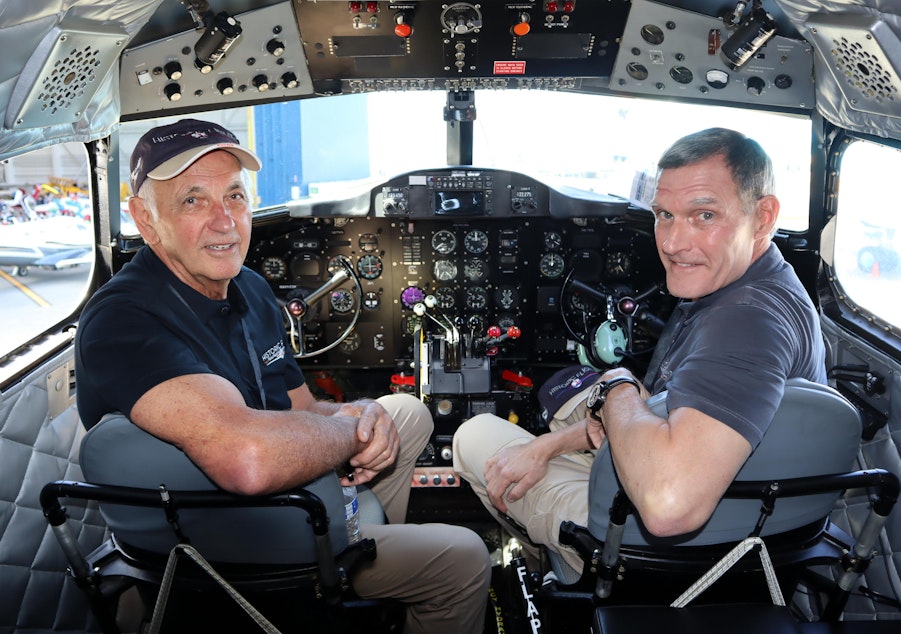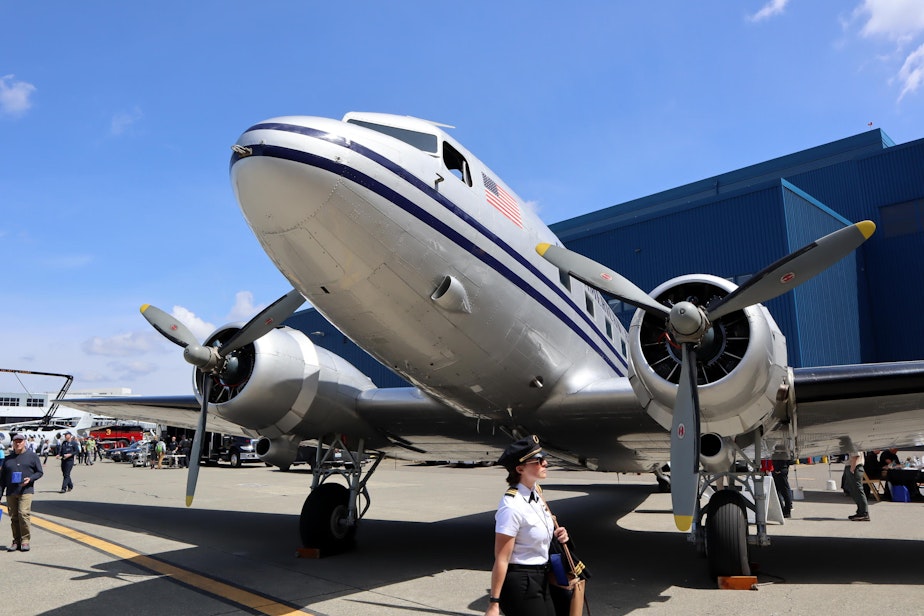Pacific NW pilots will fly a special plane in D-Day and Berlin Airlift commemorations
Get ready to hear a lot of World War II memories: The milestone 75th anniversary of D-Day is tomorrow, June 6. Pilots from the Pacific Northwest aboard a historic plane have arrived in the United Kingdom to take part in a reenactment of the invasion of Normandy.
After wowing veterans and heads of state on the ground below in France, the plane and its Northwest crew will fly onward to Germany to participate in Berlin Airlift commemorations. The double-dose of 20th century history has meaning for crew members, most of whom weren't yet born when it happened.
At Seattle-Tacoma International Airport last month this month, retired airline pilots Eugene Vezzetti and Bill Mnich showed off the WWII-era, twin-engine Douglas DC-3. The 75-year-old plane has been carefully restored and is in good flying condition, which is important because Vezzetti, Mnich and other aviation nuts just flew it across the unforgiving North Atlantic.
"Tell us, 'Don't get wet on the way,'" Mnich advised with a smile before takeoff. All of the historic planes bound for Europe carried life rafts and cold-water survival suits in case of an ocean ditching.
In southeast England, the pilots and the plane will rendezvous with more than 30 other American and European DC-3s, or C-47s as the military variant is called. Among the other expected arrivals for the D-Day Squadron is an even older DC-3 formerly flown by Eastern Air Lines. That vintage 1937 plane is now owned by a private collector from suburban Portland under the business name Blue Skies Air LLC.
Today the planes will take off together, cross the English Channel in formation and then just like in 1944 (except that it will be daytime) drop a large group of paratroopers in authentic attire over an original target zone in Normandy.
Sponsored
Vezzetti said to get 30 of these antique transports together at once for a reenactment will be amazing, even if it pales in comparison to the wave after wave of warbirds seen in documentary movies.
"We're obviously history buffs," Vezzetti said. "You cannot fly old airplanes and not become one. But to be a part of it, to be just a small part of this reenactment is..."
"It's really a thrill," said Mnich, completing his buddy's sentence.
"I think about it and I think it's going to be a chance of a lifetime," Vezzetti added.

Sponsored
A successful attorney and real estate developer turned pilot from Whidbey Island bought the old DC-3 in 2006. John Sessions later donated it to an air museum he founded. The Historic Flight Foundation has hangars at Paine Field in Everett and Felts Field in Spokane.
The upcoming retracing of the 1944 paratrooper drop will be especially poignant for Sessions because his father was one of the jumpers on the night before D-Day. Sessions figures he'll get quiet as his plane crosses the English Channel on June 5.
"You've heard of PTSD, right?" Sessions said in an interview. "Well, in moments like this I suffer from a different kind of PTSD. It's called the penchant to snivel disorder."
Sessions said the primary motivation for him and his brother to make this trip is to honor their father and others from the Greatest Generation who liberated Europe.
"Of course, nobody will be shooting at us," Sessions said. "So that's an advantage of being 75 years later."
Sponsored
After D-Day in 1944, Sessions' grandmother got a telegram telling her that her son was missing in action, only to get another telegram many days later saying the paratrooper had been located and that he was alive and well. Sgt. Myron Sessions, John's father, eventually received a Purple Heart decoration.
There is another dimension of the trip with personal resonance for Sessions. He was nearly killed in the crash of another Historic Flight Foundation plane — a de Havilland Rapide — which he was piloting last summer at the Abbottsford Air Show in British Columbia. His left leg had to be amputated below the knee due to severe injuries in the crash. Sessions was fitted with a prosthetic lower leg and foot. He was cleared to return to the pilot's seat in the nick of time earlier this month after going through flight testing, including on the DC-3.
The tour of the continent doesn't end in France. Germany is marking the 70th anniversary of the Berlin Airlift. There's a little known Northwest connection to that first big conflict of the Cold War: Alaska Airlines participated in the Berlin Airlift. It flew 86 military charter missions to ferry supplies from the U.S. to various staging fields in Germany. Current Alaska Airlines captain Doug Burton will hook up with the DC-3 for the airlift commemorations at five different German airfields.
"What they would do is bring all the supplies over," Burton explained. "And on the way back, we would fill the airplane full of war brides and bring the war brides back, and babies and things of that nature. Part of it is that it is fun to know that you are part of a long lineage of aviators."
The air bridge lasted just shy of a year until Russian leader Stalin realized the Allies were capable of supplying West Berlin that way indefinitely. The Soviets lifted their blockade in 1949.
Sponsored
The late 1940's were an interesting time for Alaska Airlines because the company stocked up on cheap, surplus military transport planes after WWII, but then secured only a few passenger routes to fly. Civil aviation in the U.S. was heavily regulated in the post-war period. Alaska Air survived on charter flying contracts, so the Berlin Airlift missions were probably welcome on many levels.

A few of the aircraft participating in this spring's commemorations directly participated in the events being remembered. However, the Historic Flight Foundation’s DC-3 saw action in the Pacific theater of war, not in Europe in the 1940's.
"It was specially equipped by Douglas to fly The Hump, the Himalayas," Sessions said. "It supplied Chiang Kai-shek in the war against Imperial Japan. After the war, it became one of China's first airliners."
Today, the plane is painted in vintage 1949 Pan American Airways colors to recognize its service at that time for CNAC, a partnership between Pan Am and the Chinese government.
Sponsored
In 1953, the American corporation Johnson & Johnson acquired the plane to use as a VIP executive transport. The plush interior fittings in the plane today date back to this corporate aviation phase.
The propeller-driven airplane cruises at 140 knots, which is about one-third of the cruise speed of a modern jet. The DC-3 is not pressurized, so it flies at lower altitudes too.
[Copyright 2019 Northwest News Network]

